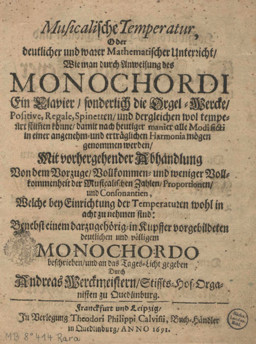Technical Library
TEMPERAMENTS VII: Werckmeister III
Entire Contents Copyright © 2020 CBHTechnical LibraryTEMPERAMENTS VII: Werckmeister III Entire Contents Copyright © 2020 CBH |
 When you feel you’ve mastered Kirnberger III, it’s an easy matter
to change it into something else, so now it’s time for Werckmeister III.
When you feel you’ve mastered Kirnberger III, it’s an easy matter
to change it into something else, so now it’s time for Werckmeister III.
(Those Darwinists reading this will, I trust, forgive me working backwards in history for ease of tuning—in musical terms, what came later was not always better!)
 MUSICOLOGIE.ORG |
| Titlepage of Werckmeister’s Musicalische Temperatur (1691) |
Andreas Werckmeister (1645–1706) was an organ expert as well as musician and theoretician. He proposed several temperaments and it is his third “correct” temperament from his Musicalische Temperatur published in Frankfurt in 1691 that is his most popular today. (Note that the various Werckmeister temperaments are numbered differently in various sources—as well as apps and electronic tuning machines!)
Completely changing the tuning of the pipes in a large organ is time-consuming and hence expensive: This temperament was probably devized for the convenience of organ tuners tasked with updating an organ from the old Quarter-comma meantone tuning, to something that could play in a wider variety of keys demanded by the then-current music, all with minimum pipework modification.
While there is no evidence that this temperament was used for anything other than organs in Werckmeister’s time, it has found favor today in ensemble music. It especially pleases violinists, who are able to preserve a pure fifth between their two top strings a'–e''. We happily used this temperament for the original instrument performances of Bach’s Brandenburg Concerti at the 2015 Carmel Bach Festival.
This is how you can change your nicely-tuned Kirnberger III into Werckmeister III on your instrument:
1. Sharpen that e' that your violinist friend so much despised, so that instead of the beautiful pure third with middle c', it makes a pure perfect fifth above a.
2. Tune down the octave to e, and raise your b so it forms a pure perfect fifth above the e.
3. Compare your b–f♯' to c'–g': As the circle shows, both these fifths are the same quarter-comma narrow and so they should beat at a similar, restless rate.
Congratulations—You’re done! You’ve tucked that last narrowed
fifth a little bit further around the circle, effectively improving the sharp keys by bringing their thirds closer to their tonics. And you
will be forever loved by your violin-playing colleagues because they needn’t
detune the top string on their fiddles.
As you gain more experience, you may want to tune Werckmeister III from scratch. Here’s how to do it from a', the note to which ensembles want to tune today:
1. Tune a' to your pitch source, and tune a an absolute pure octave below it.
2. Now find the f a third below that a: Tune it pure first of all, but then widen the interval by flattening the f until you hear two distinct beats per second. Look at the second hand on your watch if you must.
3. Tune a pure fifth from f–c'.
4. Tune all the fifths from the flat side of F around the circle of keys absolutely pure, stopping at F♯. (I’m assuming here that you’ve now done enough tuning to be familiar with the procedure of wrapping all your bearings within an octave and half or so, by dropping down an octave and tuning up a fifth; up another fifth and down an octave…)
5. Tune a pure fifth from a–e', and drop down an octave to e. Tune another pure fifth from e–b, and check the resultant b–f♯', which is the familiar quarter-comma narrow fifth.
6. Determine your g' a quarter-comma narrow fifth up from middle c', and compare it with the same-sized fifth b–f♯' a semitone lower which you’ve just tuned.
7. Drop down a pure octave to g. Fit your d' between g and a', producing the two remaining quarter comma narrow fifths.
8. Check your four narrow fifths ascending the keyboard: g–d', b–f♯', c'–g' and d'–a'. Remember that if these quarter-comma narrow fifths are to be theoretically the same size, the beat speed of each increases as the pitch rises. All the remaining fifths are pure, of course, as per the diagram.
Further discussion
Asselin, Pierre-Yves Musique et Tempérament Éditions Costallat, Paris 1985, p94
Barbour, J Murray Tuning and Temperament Michigan State College Press, East Lansing 1951, p162 (“Werckmeister’s Correct Temperament, No.1”)
Jorgensen, Owen The Equal-beating Temperaments The Sunbury Press, Raleigh 1981, p25 (“Andreas Werckmeister Well-Temperament”)
Klop, G C Harpsichord Tuning Werkplaats voor Clavecimbelbouw, Garderen 1974, p18
Padgham, Charles The Well-Tempered Organ Positive Press, Oxford 1986, p62
Veroli, Claudio di Unequal Temperaments Artes Graficas Farro, Buenos Aires 1978, p106 (“Werckmeister’s 1st temperament”)
| Pitch nomenclature | |
| Harpsichord Tuning Process | |
| Tuning Bibliography | |
| Technical Library overview | |
| Harpsichords Australia Home Page |